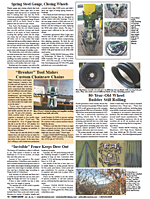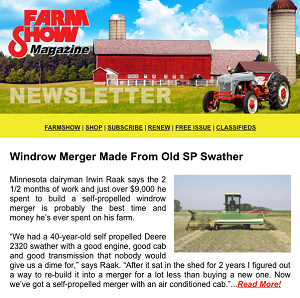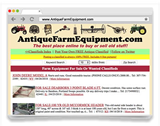Home-Built “Mower Lift” Makes Repair Work Easier
“At 74 years old I didn’t like the idea of laying down on the floor to service my riding mower, so I built a wooden mower lift that lets me work from a standing position, without having to bend over at all. I can’t believe how much easier it is to work on the mower,” says Garry Kilby, Marion, N.C.
Kilby has 46 years of experience as a machinist, and says he was careful to build the lift so that it’s strong and safe to use. He designed it for his Troy-Bilt riding mower equipped with a 42-in. deck.
The lift measures 6 ft. long, 4 ft. wide and 10 ft. high and stands on four 4 by 4 pressure treated wooden posts. A pair of electric hoists, mounted on overhead tracks, are connected by cable and chain to a wooden platform that supports the mower. The platform is open in the middle and consists of two 2 by 12 pressure treated boards bolted onto a pair of 4 by 4’s with 1/4-in. thick angle iron supports. A heavy duty chain is attached to both ends of each support, with cable running from the middle of the chain through a double pulley system and up to the hoist. Removable wooden “stops” on the boards keep the mower’s wheels in place.
Kilby drives the mower up onto the boards and uses carriage bolts to secure the stops. Then he uses a pair of remote controls to raise the mower, high enough to let him slide long steel support pipes through pairs of heavy duty eye bolts attached to the corner posts. The eye bolts are spaced about 1 ft. apart, allowing him to work on the mower at 2 different heights.
“I wanted the pipes to support the mower, because I didn’t want to take a chance that the hoists would ever fail,” says Kilby. “The upper height support works great to sharpen or replace the blades on the deck. I use the lower height to grease the mower or replace the drive belts.”
If Kilby wants, he can remove the pipes and lower the mower onto a 3-ft. tall portable workbench that’s designed to fit under the lift. “With the workbench I can unbolt the deck and roll it away into another part of the shop,” he says. “The workbench also comes in handy to work on other projects in my shop.”
The hoists ride on tracks made from 1 1/2 by 3/16-in. thick square tubing. To help keep the mower level as it’s being raised, Kilby bolted vertical angle irons onto both ends of the angle iron supports and then bolted pairs of small caster wheels to them. “The wheels are located about 1/4 in. away from the corner posts. If the platform starts to tilt as it’s raised or lowered, the wheels will contact the posts and roll up or down to level the platform,” explains Kilby.
“I installed the eye bolts securely by drilling holes through the corner posts and then adding big washers and nuts on the outside. I used threaded bolts with hex heads and big washers to secure the platform to the 2 by 12’s.”
Kilby’s total cost was less than $1,000. “I bought the hoists, which are rated at 440 lbs., at Harbor Freight for $100 apiece. I paid $10 apiece for the chains, which are each rated at 2,500 lbs.”
Contact: FARM SHOW Followup, Garry Kilby, 17 Clinton Lane, Marion, N.C. 28752 (ph 828 527-6237).

Click here to download page story appeared in.
Click here to read entire issue
Home-Built “Mower Lift” Makes Repair Work Easier FARM HOME Lawn Mowers 31h 38 “At 74 years old I didn’t like the idea of laying down on the floor to service my riding mower so I built a wooden mower lift that lets me work from a standing position without having to bend over at all I can’t believe how much easier it is to work on the mower ” says Garry Kilby Marion N C Kilby has 46 years of experience as a machinist and says he was careful to build the lift so that it’s strong and safe to use He designed it for his Troy-Bilt riding mower equipped with a 42-in deck The lift measures 6 ft long 4 ft wide and 10 ft high and stands on four 4 by 4 pressure treated wooden posts A pair of electric hoists mounted on overhead tracks are connected by cable and chain to a wooden platform that supports the mower The platform is open in the middle and consists of two 2 by 12 pressure treated boards bolted onto a pair of 4 by 4’s with 1/4-in thick angle iron supports A heavy duty chain is attached to both ends of each support with cable running from the middle of the chain through a double pulley system and up to the hoist Removable wooden “stops” on the boards keep the mower’s wheels in place Kilby drives the mower up onto the boards and uses carriage bolts to secure the stops Then he uses a pair of remote controls to raise the mower high enough to let him slide long steel support pipes through pairs of heavy duty eye bolts attached to the corner posts The eye bolts are spaced about 1 ft apart allowing him to work on the mower at 2 different heights “I wanted the pipes to support the mower because I didn’t want to take a chance that the hoists would ever fail ” says Kilby “The upper height support works great to sharpen or replace the blades on the deck I use the lower height to grease the mower or replace the drive belts ” If Kilby wants he can remove the pipes and lower the mower onto a 3-ft tall portable workbench that’s designed to fit under the lift “With the workbench I can unbolt the deck and roll it away into another part of the shop ” he says “The workbench also comes in handy to work on other projects in my shop ” The hoists ride on tracks made from 1 1/2 by 3/16-in thick square tubing To help keep the mower level as it’s being raised Kilby bolted vertical angle irons onto both ends of the angle iron supports and then bolted pairs of small caster wheels to them “The wheels are located about 1/4 in away from the corner posts If the platform starts to tilt as it’s raised or lowered the wheels will contact the posts and roll up or down to level the platform ” explains Kilby “I installed the eye bolts securely by drilling holes through the corner posts and then adding big washers and nuts on the outside I used threaded bolts with hex heads and big washers to secure the platform to the 2 by 12’s ” Kilby’s total cost was less than $1 000 “I bought the hoists which are rated at 440 lbs at Harbor Freight for $100 apiece I paid $10 apiece for the chains which are each rated at 2 500 lbs ” Contact: FARM SHOW Followup Garry Kilby 17 Clinton Lane Marion N C 28752 ph 828 527-6237
To read the rest of this story, download this issue below or click
here to register with your account number.











